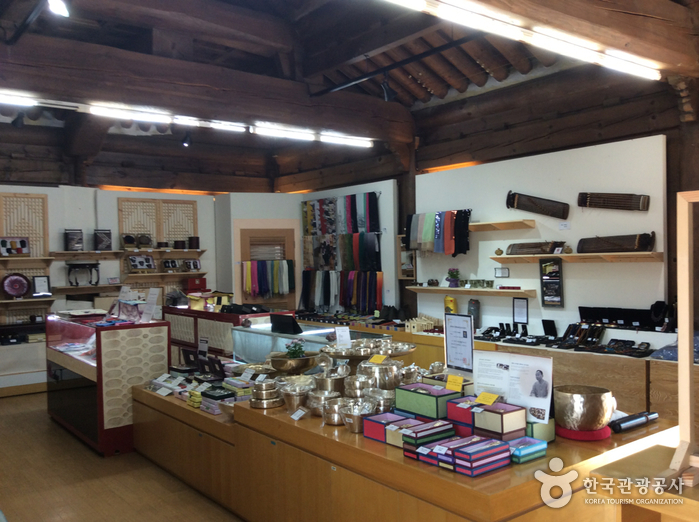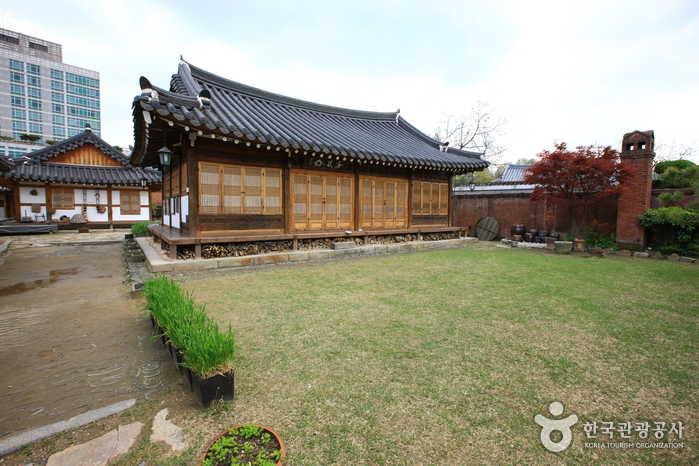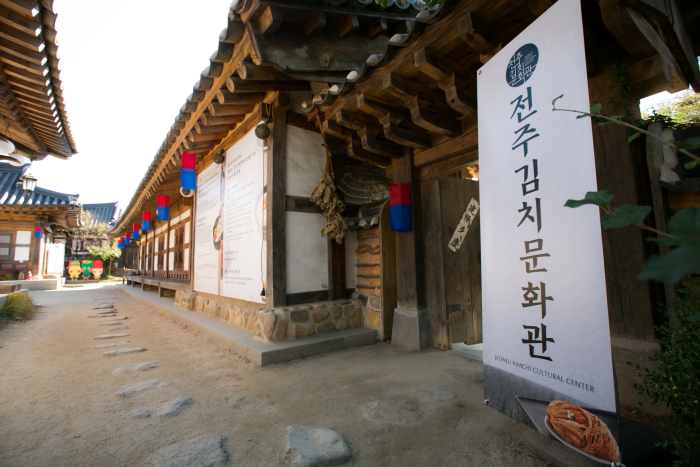Damun (다문)
489.8964685799036m 8127 2024-04-07
74-8, Eunhaeng-ro, Wansan-gu, Jeonju-si, Région Jeonbuk
+82-63-288-8607
Situated in Jeonju Hanok Village, Gyo-dong, Jeonju-si, Damun serves Korean table d’hote in a restaurant divided into large and small rooms within a hanok building structure.
Ilrakdang sarangchae [Korea Quality] / 일락당사랑채 [한국관광 품질인증]
510.393902425132m 2872 2024-04-07
15, Choemyeonghui-gil, Wansan-gu, Jeonju-si, Région Jeonbuk
+82-10-3084-6679
A must visit place for tourists in Jeonju, Ilrakdang Sarangchae is located in the middle of the traditional Korean house village of Jeonju. The very first of three enjoyments for noble man, as indicated by Menicus, the existence of parents and brothers with no troubles is what the place is named after. Standing in the garden, you can easily see the stone walls of Gyeonggijeon and also you are within the range of walking distance to Jeondong catholic church, Omokdae, Southern market, Jeonju Hyanggyo, and the wall painting village of Jaman.
The rooms are called, Haengbokchae, Sarangbang, Mitum band, Monday, Tuesday, Wednesday, Thursday, Friday, Saturday, Sunday and so on. Haengbok room 1/2, a living room with furnace, a big sized attic above the living room are shared together, which makes it most suitable for big families or a small group of tourists. The Monday/Tuesday/Friday/Saturday/Sunday rooms all have a small, cozy attic and in every guest room’s wall, column and doors are mainly made of woods which makes them feel very warm. On every morning, in the shared kitchen, simple breakfasts mainly consisting of toasts, jams, coffee and juice are served. All guests are provided with discounts on Korean costume rental(30%), motor bikes(30%) and waengi bean sprout soup with rice (1000KRW). Besides, there are various services such as introduction to tasty restaurants in partnerships with traditional Korean house villages, as well as discounts, and try out of Korean rice cake making experiences and so on.
Centre des trésor de Jeonju (전주 공예품전시관, 명품관)
527.0883218692389m 1521 2024-04-07
15, Taejo-ro, Wansan-gu, Jeonju-si, Région Jeonbuk
+82-63-285-4404
Pour les personnes recherchant de l'artisanat de haute qualité dans la région de Jeonju, le Centre des Trésors de Jeonju est l'endroit idéal pour faire des achats. Le Seonjacheong propose des éventails traditionnels, le Hanjigwan met en vente des produits fabriqués en papier coréen traditionnels, et l'Omokdae expose des objets en bois et d'autres produits. Il est très agréable de s'y promener et d'y admirer les produits, même si vous n'avez pas l'intention d'acheter.
Dongnagwon (동락원)
534.4920483861225m 5946 2024-04-07
33-6, Eunhaeng-ro, Wansan-gu, Jeonju-si, Région Jeonbuk
+82-63-285-3490
La maison Dongnagwon est une bâtisse représentative du village de Hanok de Jeonju, offrant l’opportunité d’effectuer un ‘Hanok Stay’ (passer la nuit dans une maison traditionnelle coréenne) et de vivre la vie coréenne traditionnelle. Affiliée au collège Kijeon de Jeonju, Dongnagwo est aussi un lieu de commémoration à la mémoire de W. M. Junkin, venu en Corée en 1892 en tant que missionnaire, et originaire de l’église presbytérienne du sud des Etats-Unis. Dongnagwon est une structure hanok traditionnelle consistant en un Anchae (bâtiment principal), Sarangchae (maison détachée) et Haengnangcha (maison des domestiques). Elle représente parfaitement l’agencement des vieilles maisons hanok de Jeonju à l’époque où W. M. Junkin effectuait ses travaux religieux dans la région. Les visiteurs de Dongnagwon ont la possibilité de s’essayer à la vie traditionnelle coréenne en passant une nuit dans une chambre du hanok, mais également en découvrant la musique traditionnelle, l’artisanat local et la dance. De plus, Dongnagwon propose également l’hébergement de groupes ou l’accueil lors de l’organisation de conférences, séminaires et évènements familiaux. Pour les groupes supérieurs à 30 personnes, il est possible de louer le site entier (couvrant toutes les zones du site, incluant Seungdokdang, Seunghwadang, Cheongyuje, et le jardin de devant).
Hakindang [Korea Quality] / 학인당 [한국관광 품질인증]
543.1292055954323m 12809 2024-04-08
45, Hyanggyo-gil, Wansan-gu, Jeonju-si, Région Jeonbuk
+82-63-284-9929
Hagindang was built by the same master builder and carpenter who took part in building the palaces. It's the oldest traditional Korean house in Jeonju Hanok Village and a city/province-designated Folklore Heritage No. 8 situated in Hyanggyo-gil. It has a tall gate in the middle of high walls on either side, behind which are a large front yard with a pond as well as trees surrounding the pond. The house behind this pond is in perfect harmony with the landscape. Right next to the tall gate are a detached building called “sarangchae” and an area designated for experiencing Korean tradition, including another detached building called “byeoldangchae” behind the main building named “Hagindang.” Bonchaedaegwan, which consists of three rooms named “Baekbeomjisil,” “Haegongjisil,” and “Injaejisil” exude elegance and grace The “sarangchae” is a stand-alone building with two rooms with an open living room called "daecheong" in between, making it a perfect place for an entire family to stay. The "byeoldangchae" has a total of three rooms, and the first one (Room No. 1) has a tea room with three windows made of thin wooden frames on three sides. Hagindang serves traditional Korean breakfast like the head family.
Gyodonggaon [Korea Quality] / 교동가온 [한국관광 품질인증]
546.4638625497719m 7285 2024-04-07
73-1, Eunhaeng-ro, Wansan-gu, Jeonju-si, Région Jeonbuk
+82-10-5106-3355
Gyodong Gaon is located right in the middle of the main street of Jeonju Hanok Village. The word "gaon" means "middle" in Korean. It's a two-story traditional Korean house that stands out among the rest of the traditional Korean houses in the alley leading to Omokdae. Just inside the gate is a yard with colorful flower trees, jars of sauces, and furnace. The mural on one of the walls is popular among the guests as a place to take photos.
The "numaru", or "loft" in Korean, overlooks the Hanok Village, and is one of the best places in the village to get a closer look at the 500 year old zelkova tree and the foot of the mountain nearby. Open to all the guests, the "numaru" is very popular during the winter as well as the summer. It's an open space with a wooden floor, so it's very cool during the summer, and it also serves as an observatory to enjoy the view of all the snow-covered trees and roofs in the Hanok Village during the winter while having a hot cup of tea.
The owner of the guesthouse has been living here for 37 years. He rebuilt his house and turned it into a hanok guesthouse in 2014 while making sure the rooms are well insulated and comfortable to stay.
He built a two-story building to make an efficient use of the space, and focused on making all the rooms look different. The house has five rooms, and only the “Meomulda Room” on the first floor is the only rooms with a living room separated from the bedroom. All you have to do is open the door to enjoy the view of the yard, Hanok Village, and Omokdae. The “Nanuda Room” on the second floor is the largest one that can accommodate more than five people, making it the most popular choice among families. The "Damda Room" and "Kkumkkuda Room" both have an attic that can be reached by a ladder. The attic is big enough to sleep two adults, and some guests actually sleep there for a unique experience. One of the walls of the attic is finished with cypress wood which has a pleasant scent. The “Geurida Room” has the best view through the two windows on the either side of the room, in addition to warm sunlight and cool wind that come through the window. Modern, not traditional, doors are installed in all the rooms for better sound proofing and insulation.
Gyodong Gaon offers a number of experience programs, such as traditional games like “gulleongsoe”, “tuho", and “Korean top”, As well as “sabang chigi”, “sampalseon”, and “ttangttameokgi”.
Many Korean adults are familiar with these games, while children and foreigners can find these games interesting. All these traditional Korean games are free to play.
GaEunChae2 [Korea Quality] / 가은채2 [한국관광 품질인증]
554.5343397985371m 204 2024-04-07
100-20, Hanji-gil, Wansan-gu, Jeonju-si, Région Jeonbuk
+82-10-6335-5267
Gaeunchae 2 is the sister accommodations of Gaeunchae and is located behind the Jeonju Korean Traditional Wine Museum. Completed in 2011, the traditional Hanok has soil walls and soil Ondol floors finished with traditional Hanji wallpaper and Hanji floor paper for greater traditional beauty. The exposed rafter and gray wall design make for the unique interior atmosphere of Hanok. Sculptures such as stone lantern and stone tiger in the garden, old rectangular stone, and terrace stone in the yard make the Hanok even more elegant. The small floor in the room just in front of the door is a versatile space where one can put luggage or sit and have a chat.
Being situated close to the busy Taejoro in Jeonju Hanok Village, Gaeunchae 2 offers easy access to major tourist sites of the village including Jeondong Catholic Cathedral, Gyeonggijeon, Imokdae, etc. which are within walking distance. Guests can have a food trip as well as visit great restaurants and cafes clustered nearby.
ONEWWAL[Korea Quality] / 오뉴월[한국관광 품질인증/Korea Quality]
562.9653432678185m 101 2024-04-07
51-5, Hyanggyo-gil, Wansan-gu, Jeonju-si, Région Jeonbuk
+82-10-3670-2581
Onyuwol is a “hanok” guesthouse located in Jeonju Hanok Village. It is attached to a café that combines hanok and modern interior design and has enjoyed considerable popularity via word-of-mouth among young travelers. There are five rooms in total, which are furnished comfortably like their namesakes (the months of May and June). The rooms bear the hallmark elegance of hanok, from their exposed rafters to red clay floors, white cotton beddings, and muslin curtains. The furnishings remained minimalist, with only bedding, a small TV, electric kettle, and a basket containing a towel, hairdryer, and a hand mirror. The sleep-themed room names show that they are furnished with a restful stay in mind. Opening the door brings guests to the view of the peaceful garden. Nabijam and Kkotjam rooms have small attics that add a layer of elegance, while only the Danjam room is furnished with a bed. All rooms are equipped with bathrooms. Guests can also enjoy a complimentary cup of Americano in the café, and international guests have access to English services. Furthermore, its location makes it a good starting point for visits to Jeonju’s major tourist sights, such as Jeonjuhyanggyo Local Confucian School, Gyeonggijeon Shrine, Omokdae Historical Site, or the alleyways of the historical city.
GaEunChae [Korea Quality] / 가은채 [한국관광 품질인증]
574.3329711701998m 429 2024-04-07
68-13, Hanji-gil, Wansan-gu, Jeonju-si, Région Jeonbuk
+82-10-6345-5267
Gaeunchae is a Handol guesthouse located in Jeonju Hanok Village. Among the four Hanok buildings built by a construction company in 1969, two are being operated as a Gaeunchae guesthouse. While turning it into a lodging place, everything related to a private house was removed, but the original form of the building was revived for guests to feel the beauty of the traditional Hanok.
Jeonju Master's Crafts Center, Jeonju Korean Traditional Wine Museum, Seunggwangjae, Dakjongi Hanji Dolls Workshop, etc. are just a stone's throw away. In particular, the pretty alleys are part of the Hanok Village alley tour course 1 operated by Jeonju City.
In the middle of the yard of Gaeunchae are stones refined by hand years ago, including Macheon Stone, Sago Stone, Goheung Stone, Hwangdeung Stone, etc; the southern yard is paved with flat stones such as old granite, bakseok, and mica. Traditional room doors fitted without using any nails and traditional windows add to the gracefulness of Hanok.
Centre culturel de kimchi dans le village hanok de Jeonju (전주한옥마을 전주김치문화관)
575.9008548846651m 5262 2024-04-07
29, Eojin-gil, Wansan-gu, Jeonju-si, Région Jeonbuk
+82-63-287-6300
Le centre des expériences de vie traditionnelles de jeonju est un guest house situé dans le village de hanok de Jeonju. Les visiteurs peuvent y vivre une expérience unique de la vie en habitat traditionnel. Le centre était à l’origine une résidence de noble construite durant la dynastie Joseon (1392-1910) aujourd’hui reconstruite, elle accueille de nombreux visiteurs notamment des étrangers qui peuvent y découvrir le côté traditionnel de la Corée. L’habitat a perdu de son côté vetuste mais y a gagné en comfort. Les visiteurs peuvent s’amuser à découper le bois pour alimenter le système traditionnel de chauffage. Il s’agit du ondol, un système de chauffage qui irradie l’ensemble du sol par dessous. Les visiteurs dorment sur des petits matelas à même le sol où il est bon de se prélasser durant les journées froide d’hiver.
Dans ce guest house, les hôtes peuvent également apprendre des chansons traditionnelles, y prendre le thé, ou encore faire du vélo autour de la propriété. Les repas sont compris dans le prix de l’hébergement.

![Ilrakdang sarangchae [Korea Quality] / 일락당사랑채 [한국관광 품질인증]](http://tong.visitkorea.or.kr/cms/resource/57/2596657_image2_1.jpg)



![Gyodonggaon [Korea Quality] / 교동가온 [한국관광 품질인증]](http://tong.visitkorea.or.kr/cms/resource/75/2049675_image2_1.jpg)
![ONEWWAL[Korea Quality] / 오뉴월[한국관광 품질인증/Korea Quality]](http://tong.visitkorea.or.kr/cms/resource/97/2651897_image2_1.jpg)

 Français
Français
 한국어
한국어 English
English 日本語
日本語 中文(简体)
中文(简体) Deutsch
Deutsch Español
Español Русский
Русский